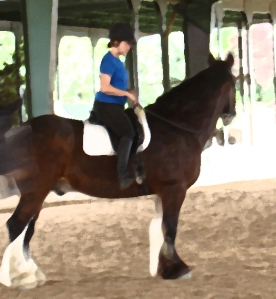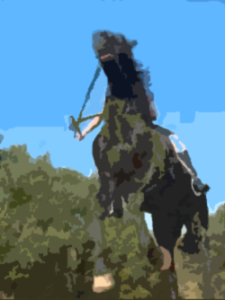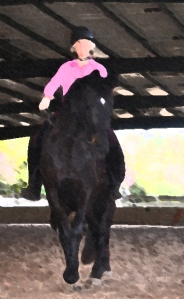 Fear is an emotion I have often encountered as well as noting it in others. An interesting definition I found describes fear as “a feeling of anxiety concerning the outcome of something.” Of course, there are the obvious motivators for fear that include our sense of pain or danger. But I was most intrigued by the phrase “anxiety concerning outcomes,” because even while we, as horsemen and women, are confronted with fears of being run away with, bucked off, or when we are just plain intimidated by the size and power of our equine counterpart, most of our day to day concerns have nothing to do with actual threats. They are caused by our perceptions of potentially unwanted outcomes, particularly if we are in an environment where others can see (and judge) what we say and do. For me, these tend to be more subtle, insidious fears, not so obvious and often the kind I am not aware of.
Fear is an emotion I have often encountered as well as noting it in others. An interesting definition I found describes fear as “a feeling of anxiety concerning the outcome of something.” Of course, there are the obvious motivators for fear that include our sense of pain or danger. But I was most intrigued by the phrase “anxiety concerning outcomes,” because even while we, as horsemen and women, are confronted with fears of being run away with, bucked off, or when we are just plain intimidated by the size and power of our equine counterpart, most of our day to day concerns have nothing to do with actual threats. They are caused by our perceptions of potentially unwanted outcomes, particularly if we are in an environment where others can see (and judge) what we say and do. For me, these tend to be more subtle, insidious fears, not so obvious and often the kind I am not aware of.
Let me elaborate.
It used to be that when I would begin working with a horse, the first thing I expected was his attention. If he didn’t respond to what I was asking, I would insist, becoming heavier-handed. If that didn’t work, anger would rise up and a battle would ensue. I justified my actions by telling myself that demanding attention was a no-brainer. “You can’t accomplish anything without it,” was what I was taught. Besides, who doesn’t want their horse to pay attention to them? It’s like a basic right, right? But there was more to it than that, because even after I learned more effective training methods, I still got angry when they didn’t respond the way I thought they should. I had learned new technical skills, but I hadn’t changed.
It wasn’t until years later, after I learned that not having all the answers was okay and working with horses is often a messy-looking process, I had a small epiphany. My anger was a mask, or better yet, a defense against something that seemed more ominous yet equally vulnerable and defenseless. I could sense it, but I couldn’t name it. I knew it was important to come to terms with, but it felt too uncomfortable and so each time I caught a glimpse, I’d just as quickly distract myself so I wouldn’t have to think about it. At the same time I was aware of a vague sense of self-criticism for not dealing with it. I mean, what was up with me? The funny thing is, once I seriously asked myself that question, I immediately knew the disquieting answer.
I was afraid. Major revelation number one.
Major revelation number two was that I was ashamed of my fear. No wonder, then, it had been so hard for me to admit. Fear is for sissy’s, I had been told since I began riding at four, certainly not an appropriate emotion around horses. A horseman couldn’t be afraid or the horse would sense it and refuse to show respect.
Okay. So I was afraid even though I wasn’t “supposed” to be afraid. But I wasn’t usually afraid of the horse itself, so what else could it be? I thought of the many horses I’d ridden into situations or past objects that made them fearful. “It’s not going to hurt you,” I’d state aloud what seemed obvious to me. But they’d be afraid anyway. I’d judge their behavior as silly, unnecessary, pea-brained, dim-witted, and on and on, all the while trying to force them past the object or situation. Just get over it, was my attitude, so I can get on with your training. You know, the important stuff. (By the way, is it any surprise to note that the object of their fear was taking their attention away from me?)
Over the years I learned that it was a natural instinct for a horse to turn and bolt away from the object of their fear because in their mind, it was threatening. And the fact that I hadn’t stopped to seriously think about my own fear until that moment meant that I’d been bolting from some invisible and most likely conjured-up threat for much of my life as well.
Major revelation number three.
When I first accepted that I might do well to respect the natural instincts of a horse, a modicum of newly-formed compassion led me to the common idea that if I showed the horse the object of their fear, they’d “get over it.” While it can work just this easily in some circumstances, I learned the hard way that for many horses it’s not enough and, sadly, went through another phase of kicking and cursing in an effort to make them “go up and look at the thing” so they could hurry up and get over it. The result was the same as before: a horse who not only remained afraid of the object but mistrustful of me as well. How interesting, then, to eventually realize that this pretty much summed up the way I felt about myself. Why couldn’t I just hurry up and look at what I was afraid of so I could get over it?
More time passed and I eventually had the opportunity to observe a horse’s inherent ability to resolve his own fear. By this time I’d had enough experience to note that while I could coerce a horse to comply with my wishes, I could not force him to relax in a tense situation. He must learn to do that for himself, emotionally from the inside. To enable this to happen, I had to learn to facilitate an environment within which that psychological process could take place — and so began my exploration into the meaning of true partnership. I saw that both his experience and mine greatly improved when I employed a sincere feeling of appreciation for this animal I had loved my whole life, and simply did whatever it took to allow him to do whatever he needed to assuage whatever uneasy sense he might have at any time. Period. It was at this point in my unfoldment that it finally dawned on me to use what I was learning to do for the horse as a way to help myself address my own fear.
First, when a horse reacts to an object of their fear, I don’t force him to look at it. I let him turn and bolt. For just a few moments. Then, like the lead mare in a herd responsible for choosing the direction of its members, I have my rein or my lead line set up to turn him, depending on whether I’m in the saddle or on the ground. As the horse runs into the pressure of the line, I direct him to turn as if to say, “this is the way out of danger.” In other words, I’m not telling him not to be afraid, but I’m holding my own ground while the pressure that he created directs where he goes. For a moment, the turn shifts his attention away from the object of his fear while slowing his feet. Sometimes a lot of poundage falls on the line before he is convinced to turn where I’m turning, but once he does, I immediately let go of my controls and feed him back the line. In that moment there is a pause, a sense of relief because he is free from the pressure and no longer feels confined or trapped.
In the next moment, he realizes that the direction he turned allowed the object of

When the horse turns, releasing the pressure on the line is vital, allowing them to think they did the right thing by going along with you.
his fear to come back into view. Now he is uncomfortable again, but I wait in order to give him the opportunity to make his own choice: continue to follow me, the voice of calm assurance, or again give sway to his fear. It is common that there are several or more times that he chooses to yield to his fear before deciding to softly follow my lead. Perfectly understandable. How many times each day do we choose not to look at something because it’s uncomfortable? It’s not usually a different issue, but the same one we never confront, over and over again. The truth is, being uncomfortable sucks, and our resulting internal squirm tends to lead us to the distractions that allow us to feel like
we’ve gotten “away,” otherwise known as “being in denial.”

Sometimes, letting a horse look and giving him time to assess what’s going on around him is all that’s necessary for him to settle.
So, why did I continue to shame myself for being afraid long after I’d learned to have compassion for a horse’s fear? By the time I figured out this question, I already knew the answer. I had practiced a punitive attitude toward myself for so long it felt “normal,” until my discomfort about that kind of self-talk grew strong enough to prompt me to question my old ways. Ahhh… the purpose of “negative feelings,” telling us when we’re off course and out of tune with our better nature.
Major revelation number four.
Where had I learned this punitive attitude? I remembered how much of the first seven years of my life were spent being afraid. The way I learned to get through that time was to buck up and move on, a way of using my inherent strength to cope. This initially allowed me to function as if all was normal, but it increasingly got in the way of my ability to feel positive about living. For me the discomfort was very real, and denial provided a much craved-for sense of relief — at least for a while. The only problem was that I thereby kept myself a slave to my fear, and powerlessness to change.
Major revelation number five.
But back to the horse. Even when he decides not to run away but instead go along with me, he will still want to keep a wide berth around the object of his fear if he has not yet resolved anxiety about it inside his own mind — just like each of us must do in order to feel at peace. So, if I try again to force him to the object at this point in the process, mistrust in me will be reinstated, and he will hang onto his fear. But if I quietly direct him around the object and occasionally let him move away from the object when he needs relief from the intensity of his emotional discomfort, then he can begin to observe it from a distance, i.e. in perspective.
Here is when a marvelous, natural transition occurs. Curiosity takes over.
Major revelation number six.
When curiosity emerges, the less I do the better. The object becomes like a magnet and the horse is suddenly drawn to it. Like a cat he will creep forward cautiously, neck elongated and nose extended, engaging his own sense of discernment (via sight and smell). When he has had sufficient time to assess the object from whatever distance he’s at, he will move closer, often with interspersed moments of snorting, being startled, turning away, thinking that it really is too scary, etc. If he tries to bolt again, I am there to redirect until his curiosity returns and I can revert back to a more passive stance.
Eventually, he will get close enough to touch the object with his muzzle, cautiously at first, but ultimately showing great enthusiasm for smearing his nose around and licking it with his tongue, now employing his sense of taste and touch to further familiarize the object to himself. If I give him sufficient opportunity to satisfy this curiosity, he will often very quickly drop his concern and the next time he sees it, treat it as if it no longer exists. The entire transition from fear to ease can happen in no time if I do not feel inconvenienced or fall back into the old punitive and critical mind-set, a precursor to acting out of impatience and trying too hard to make (instead of allow) what I want to have happen.
Major revelation number seven.
So I asked myself, What would it be like to be curious about my fear rather than default to a punitive sense of myself for feeling it?
Well, that would necessitate trusting and honoring my innate ability to re-frame the experience, as opposed to changing my self-image to appear acceptable.
You mean, let go of trying to control outcomes? A scary thought indeed…
Yes, but intriguing! (Wait… is that curiosity speaking?)
…and uncomfortable!
Yes. Same as it is for the horse. But maybe temporary discomfort is worth the awareness. Being aware of an emotion (like fear) means that I can decide whether or not it dictates my behavior and life choices, putting me in the driver’s seat and empowering my self.














Hi Terry – another thought-provoking (ok, and somewhat uncomfortable at times) article. I so appreciate your perspective and sharing some of your learnings. The article made me think of a concept Thich Nhat Hanh calls “habit energy”. Responding to situations and things by habit rather than thoughtful intention. Often we don’t even realize that’s what it is. Sometimes it’s “fun” to work on and sometimes – not so much! At least that’s my experience with it. Eager to read more – hugs!
Yay! Glad it was thought-provoking. Thich Nhat Hanh is very cool… Thanks for replying your thoughts!
Patience … as brilliant and insightful as this of course is, the shining light under it (as always) it seemed to me, is your value of time and patience. When I think back on my experiences years ago with some of those big name clinicians ~ I compare their approaches to fear in the horse with this beautiful offering of deeper wisdom. I realize that a huge glaring difference is the simple fact that for those gentlemen back then – , it was about “getting er’ done” on THEIR time – not the horse’s. It was about working through the fear as an assertive leader – not a partner. It was about pushing through that scary tarp in the moment of the clinic – ironically *out of fear of the consequence* in the horse if he didn’t go through it – not understanding that it wasn’t ~ something to fear.. Wow … always …. thank you for the so many layers of truth you offer dear Terry – on so many things ♥
Thanks, Sue! Love ya…
I like the idea of helping horses to be FEARLESS. We ask so much of horses so that we might enjoy the pleasure of riding. Some of us want to do dressage with our horses, some of us show jumping, eventing, or trail riding. In teaching the horses to accomplish jumping a jump or going down a steep hill, etc., they sure need to be fearless. Thank you Terry for illustrating so clearly and concisely the complete importance in teaching a horse the fundamentals of ground work to overcome fear and to be on the way to becoming fearless.
Also, the humbleness it takes for us to take that look at our own fears.
For me, doing these tasks with our beloved Equines has helped me to overcome fears within me. Horses can be great healers!
Great topic! Much food for thought.
Healers indeed. Thanks, Sarah!
My first horse, a scardey-cat draft-cross gelding, taught me so much about myself and the majority of the learning was about my fear. Although I loved him dearly, I could not trust him and had to let him go. He went to a woman who is a perfect match for him and I found my next horse, a young mare. She typically moves quickly from “Aaaack, what’s that?!?” to cautious curiosity with gentle and firm prompting from me. This is an unceasing source of joy to me.
Thank you, Terry, for reminding me to extend myself the same gentle and firm leadership that I offer her. The joy wells up just thinking of the possibilites!
Lovely!